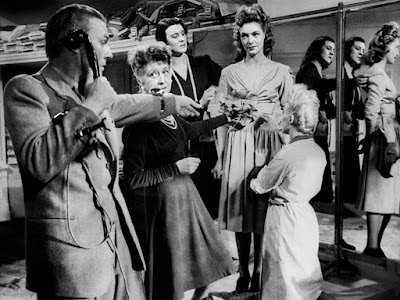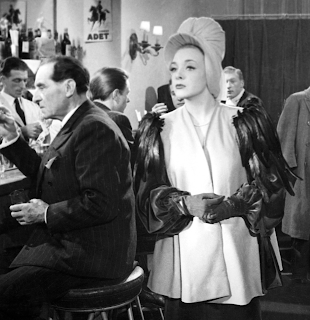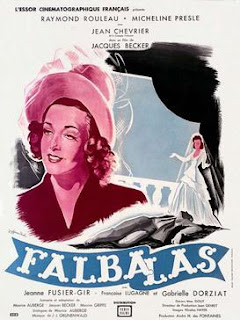You could have knocked me over with a feather (reference is relevant) as "Falbalas" is a fashion film I had never heard of, let alone seen. It's a noir-ish French drama from 1945 about a successful couturier and his doomed romance. There is definitely a connection with this and 2017's "Phantom Thread", a fact celebrated by TCM's pairing the two as part of their "Follow the Thread" series.
 |
| Phillipe creating while making a phone conquest |
"Falabalas" is fascinating on many levels, notwithstanding how the title translates to "Paris Frills". Released in 1945, there is a calendar on set that says "1943". It hadn't occurred to me that Paris, squarely under the Nazi regime, was not only producing films but lavish couture as well. I do know the story, told well in the book "Miss Dior" and other sources, how important it was for the French to have the couture houses stay open. Chanel closed hers but many others tried to keep going for their thousands of (mostly women) employees.
 |
| "Phantom Thread" |
In "Falbalas" the successful designer, Phillipe Clarence, is in the midst of preparing his new line and not happy with what he's created. He blames the failure of one dress on his fabric supplier and seeks him out to complain. We already know Phillipe is a cold Don Juan, but he falls for the supplier's pretty young fiancee, a striking Micheline Presle, who has wider set eyes than Jackie Kennedy and is still alive today at age 99. Phillipe toys with Micheline (her name in the script as well), drops her, changes his mind, is rebuffed (though saintly Micheline decides she can't marry the other man either), goes mad and kills himself.
 |
| Micheline as Micheline |
Okay, I gave away the plot, but the movie begins with Phillipe dead after jumping from a window, landing on a mannequin wearing Micheline's scorned wedding gown. One of the passersby remarks it was lucky the mannequin didn't break.
 |
| The "girls" of the couture house |
As did "Phantom Thread", "Falbalas" accurately portrays life in a couture house—the personalities who run the place, including a stern but sympathetic vendeuse, and the many young women whose fingers do the sewing. The fashions were designed by Marcel Rochas, who opened his own couture house at age 23 in 1925 and designed until his death in 1955. The brand continues to this day. Rochas' style was perhaps the polar opposite of Chanel's. He believed in femininity and thus possibly the "frills" of the title. His costumes for the film are perhaps a little over the top, as costumes may be, but still have a wearable flair.
 |
| Rooster? Crow? Buzzard??? |
One of the early pieces we see is an outfit designed as a surprise for Micheline. Make-do was de rigueur; some poor barnyard animal contributed to those shoulders. The hats, which were huge as was the style, were designed by someone else (and never seem to match the clothes). The shoes were clunky as they were wood or cork, the leather being shipped off to make boots for German soldiers. As a subplot the fabric supplier is in the midst of renovating a grand apartment for his bride-to-be. Where did this luxurious space come from in Nazi-occupied Paris?
There is not a Nazi or a mention of WWII in the film. It's fashion after all, and fantasy is a big part of fashion. Its two universal themes are women love to look beautiful and love makes the world go round.
This little treasure seems available to watch on Apple tv with a 1:32 minutes trailer available on YouTube. Enjoy.


No comments:
Post a Comment